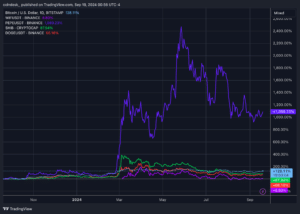SINGAPORE – Constructing an investment portfolio is often said to be mostly a science and partly an art. If Joe McCann, founder of digital asset investment firm Asymmetric, and big-name crypto trader Ansem are to be believed, the art component is perhaps equally as important as the science bit.
During a panel at this year’s Token2049 crypto conference on Thursday, both argued that memecoins — inarguably a manifestation of art — ought to be included in any digital asset investor’s portfolio, especially following Wednesday’s U.S. Federal Reserve announcement of a 50 basis point cut in interest rates.
McCann told conference attendees to expect more liquidity to come into the market as a result of the rate cut.
“The reality is the Federal Reserve and the central banks are going to be printing money … [which is] going to allow people to go further out on the risk curve,” he said. “I think having exposure to memecoins is the highest risk-return you could possibly have in a portfolio.”
Read more: Can Memecoin Mania Help Revive Ethereum’s Deflationary Dreams?
In a similar vein, Ansem argued that in the current cycle “memecoins have been the best beta,” referring to a leveraged play on the native tokens of blockchain networks such as a memecoin beta for Solana token SOL not only being correlated with SOL, but yielding a return many times higher than SOL itself.
Memecoins are the “next evolution of a meme, but also the standard original rendition of what memetics is,” said Iggy Azalea, the founder of memecoin MOTHER, who joined the panel late.
“Memes have been adopted by internet culture and so now we have this modernized version of how we think of a meme,” she said.
Azalea and a number of other celebrities launched tokens through Solana-based memecoin factory Pump.Fun in May. She has been the biggest winner among them, with her token reaching a market cap of nearly $55 million, according to CoinGecko.
The biggest and most important attribute of memecoins is the community around them, said Ansem, who pointed to Bitcoin’s origins as an example.
He said that in 2009, when Satoshi Nakamoto conjured up Bitcoin, the original cryptocurrency had no value on exchanges or “anywhere really.”
“The only thing that made the [Bitcoin] network have value was all of the running values on the network and all the people holding bitcoin who believe in it … That’s purely a memetic value in the early days,” Ansem said.
Read more: 2 Professional Crypto Investors Made Huge Gains on Memecoins: Here’s How They Did It
Currently, the biggest coins by market cap are those based on dogs, frogs, and cats.
“[But a meme] doesn’t have to be an animal, a human being, any of these types of things,” McCann said. “It could be literally a phrase. We’re at the very beginning of how crazy this shit is going to get, because … things can just programmatically tokenize culture.”

The fondness of Azalea, McCann, and Ansem for cryptos based on internet culture and online jokes comes against the backdrop of a memecoin industry that has attained a market cap of $43 billion — up 4.3% in the 24 hours before press time alone — per CoinGecko.
Yet only one of the top four memecoins ranked by market cap has outperformed BTC in the past year, according to data from TradingView: frog-based PEPE, whose value has risen 1,090.8%, or 10-fold, far outstripping BTC’s 128.1% gain.


